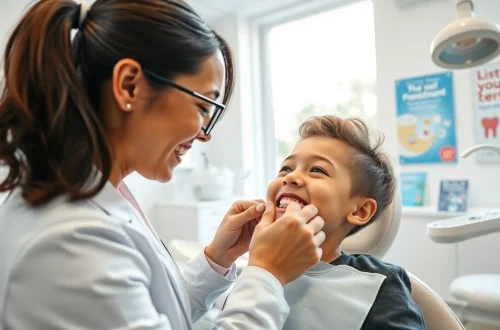Understanding Orthodontics: The Basics
What is Orthodontics?
Orthodontics is a specialized branch of dentistry that focuses on diagnosing, preventing, and treating dental and facial irregularities. Primarily, orthodontists work to correct misaligned teeth and jaws using various appliances, including braces, clear aligners, and retainers. The aim is not only to enhance the aesthetic appearance of the smile but also to improve overall oral health. Misaligned teeth can lead to a range of dental issues, including increased risk of cavities, gum disease, and difficulties in chewing and speaking.
Common Treatments Offered by Orthodontist Myrtle Beach
An orthodontist Myrtle Beach offers a variety of treatment options tailored to meet individual patient needs. Some of the most common treatments include:
- Metal Braces: The traditional method of orthodontics, consisting of metal brackets and wires to align teeth over time.
- Clear Braces: A more aesthetic alternative to metal braces, these ceramic brackets blend with the natural color of teeth.
- Invisalign: Clear aligners that are removable and virtually invisible, suitable for a range of orthodontic issues.
- Lingual Braces: Braces placed on the inside surfaces of the teeth, making them hidden from view.
- Retainers: Custom-made devices that help maintain teeth in their new positions post-treatment.
Why Orthodontic Care Matters for Your Oral Health
Many individuals may not realize that orthodontic care goes beyond aesthetics—it has profound implications for oral health. Well-aligned teeth are easier to clean, reducing the risk of decay and gum disease. Additionally, proper bite alignment minimizes the wear and stress on teeth and jaws, preventing issues such as jaw pain, dental erosion, and headaches. Ultimately, investing in orthodontic treatment can lead to improved function, health, and confidence in one’s smile.
Finding the Right Orthodontist Myrtle Beach
Key Qualities to Look for in an Orthodontist
Choosing an orthodontist is a crucial decision that can significantly impact your orthodontic experience and results. Here are some essential qualities to consider:
- Qualifications and Experience: Check for board certification and experience in the field of orthodontics.
- Technology and Techniques: A good orthodontist should stay updated on the latest orthodontic technologies and treatment methods.
- Patient Reviews: Look for testimonials and reviews from previous patients to gauge satisfaction and results.
- Personalized Care: The orthodontist should take the time to understand your unique needs and customize a treatment plan accordingly.
- Communication Style: Choose an orthodontist who communicates clearly and is easy to talk to about your concerns and treatment options.
Questions to Ask During Your Consultation
During an initial consultation, it’s essential to ask the right questions to ensure you understand the treatment process. Some key questions to consider include:
- What types of treatments do you offer, and what are the pros and cons of each?
- What is the estimated duration of my treatment?
- How often will I need to come in for adjustments?
- What are the total costs, and do you offer payment plans or financing options?
- What should I expect during the treatment process, including potential discomfort and limitations?
How to Research Orthodontists Effectively
In the digital age, researching orthodontists has never been easier. Here are some strategies to conduct effective research:
- Online Reviews: Platforms such as Google, Yelp, and social media provide insights from current and former patients.
- Professional Websites: Visit orthodontists’ websites to learn about their services, technology, and office environment.
- Ask for Recommendations: Personal referrals from friends, family, or your dentist can lead you to trusted professionals.
- Consultation Appointments: Take advantage of free consultations to meet orthodontists and assess your comfort level with their practice.
The Benefits of Early Orthodontic Evaluation
When Should Your Child See an Orthodontist?
Early evaluations by an orthodontist are vital. The American Association of Orthodontists recommends that children have their first orthodontic evaluation by age seven. This doesn’t mean that treatment is necessary at this age, but early assessment can identify potential issues before they become more severe.
Signs That Indicate Orthodontic Treatment is Needed
There are several signs that may indicate your child should visit an orthodontist, including:
- Overcrowding of teeth.
- Protruding teeth (especially the front teeth).
- Difficulty chewing or biting.
- Early or late loss of baby teeth.
- Mouth breathing.
Long-Term Benefits of Timely Treatment
Addressing orthodontic issues early could lead to various long-term benefits, such as:
- Improved smile aesthetics and self-esteem.
- Reduced likelihood of dental issues in the future.
- Enhanced oral health through easier cleaning of properly aligned teeth.
- Less complex and potentially less costly treatment options later.
The Different Types of Orthodontic Appliances
Comparing Traditional Braces to Clear Aligners
Traditional braces consist of metal brackets and wires that work together to move teeth into the desired positions. They have been a reliable treatment option for years. Conversely, clear aligners offer a modern approach, using a series of custom-made clear plastic trays that progressively move teeth. While both options are effective, clear aligners provide more flexibility and comfort, especially for adults seeking a discreet method of treatment.
The Role of Lingual Braces in Modern Orthodontics
Lingual braces are a unique type of braces placed on the inside surface of the teeth, making them virtually invisible. They are particularly popular among adults who want to enhance their smiles without the visible signs of orthodontic treatment. Although they offer aesthetic advantages, lingual braces require more time and effort for cleaning and may pose challenges in terms of speech.
Understanding Retainers and Their Importance
Once orthodontic treatment is completed, retainers play a crucial role in maintaining the new position of the teeth. There are generally two types of retainers: fixed and removable. Fixed retainers are often bonded to the back of the teeth, while removable ones can be taken out as needed. Wearing retainers as directed is essential to avoid teeth shifting back to their original positions.
What to Expect During Your Orthodontic Journey
Initial Consultation: What You Should Know
Your journey with an orthodontist typically begins with an initial consultation. During this visit, the orthodontist will conduct a comprehensive examination of your teeth, mouth, and jaw alignment. This may involve X-rays and digital scans to assess the best course of treatment. Additionally, the orthodontist will discuss your concerns, answer your questions, and outline potential treatment options.
Timeline for Your Treatment with Orthodontist Myrtle Beach
The duration of orthodontic treatment can vary significantly based on individual factors such as age, the severity of the dental issue, and the type of treatment chosen. On average, treatment can take between 12 to 36 months. Regular follow-up appointments will ensure progress is on track, and adjustments are made as necessary.
Maintaining Results Post-Treatment
Once your orthodontic treatment concludes, the importance of retention cannot be overstated. Wearing your retainer as prescribed will help ensure your teeth remain in their new positions. Regular follow-ups with your orthodontist, good oral hygiene practices, and a healthy diet will support the longevity of your results.





